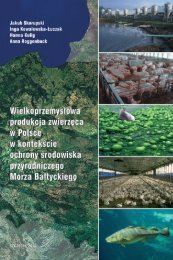best available technologies for manure treatment - Baltic Green Belt
best available technologies for manure treatment - Baltic Green Belt
best available technologies for manure treatment - Baltic Green Belt
Create successful ePaper yourself
Turn your PDF publications into a flip-book with our unique Google optimized e-Paper software.
Best Available Technologies <strong>for</strong> <strong>manure</strong> <strong>treatment</strong> baltic sea 2020<br />
Best Available Technologies <strong>for</strong> <strong>manure</strong> <strong>treatment</strong> baltic sea 2020<br />
ANNEX E: TABLES WITH SHORT DESPRIPTION OF LIVESTOCK MANURE TREATMENT TECHNOLOGIES<br />
Best Available Techniques <strong>for</strong> <strong>manure</strong> <strong>treatment</strong> - <strong>for</strong> intensive rearing of pigs in <strong>Baltic</strong> Sea Region EU Member States Technical Report "Best Practice Manure Handling, Phase 2"<br />
sensitive to pH and temperature). High efficacy but frequent re-sowing has to be carried<br />
out<br />
promote natural strains: this is based on adding carbonate substrates (increased C:N<br />
ratio). Its effect is based on the use of ammonia as a nutrient, but they need a sufficient<br />
source of C to develop an efficient synthesis process, changing ammonia on the organic N<br />
of cell tissue. Re-sowing has to be carried out too, to avoid reverting to the starting point.<br />
They are not hazardous and no significant cross-media effects have been reported.<br />
Overall efficacy of <strong>manure</strong> additives and farm use: Nowadays there are many <strong>manure</strong> additives in the<br />
market, but the efficacy has not been demonstrated in every case. One of the main problems is the lack<br />
of standard techniques to test and analyse the results. Another problem with their use is that many trials<br />
have only been developed under experimental conditions in laboratories and not on-farm, where big<br />
variations in nutrition, the management of nutrition, pH and temperature can be found. Besides this,<br />
there is also sometimes a huge volume of <strong>manure</strong> to be mixed with the additive in a pit or lagoon, and<br />
the results achieved often depend a lot more on the mixing efficiency than on the lack of efficacy of the<br />
additive. Improving the flow characteristics seems to be strongly related with a good mixing.<br />
The efficacy of every compound is highly dependent on the correct dosing, right timing and a good<br />
mixing. In some cases a small effect has been observed of an increase in the fertilising value, but this<br />
effect is related to the type of crop, the time of application and dosing.<br />
It has to be highlighted that in many cases the effects on human or animal health or other environmental<br />
effects by using additives are not known and this, of course, limits their applicability.<br />
Innovation stage<br />
Research<br />
Pilot<br />
Practice <br />
Major references<br />
European Commission,<br />
2003<br />
Investment price, <br />
Basic Variable<br />
Operational<br />
costs,<br />
per tonnes<br />
500 (small) Depends Depends<br />
Condition <strong>for</strong> leaching reduction<br />
effect<br />
More P in produced livestock <strong>manure</strong><br />
than can be consumed by the crops<br />
on the farm.<br />
Certainty of in<strong>for</strong>mation<br />
Prices High<br />
Effect on leaching Low<br />
per kg saved<br />
N or P<br />
leaching<br />
Depends on<br />
the situation<br />
of the<br />
individual<br />
farm.<br />
Low<br />
Complexity of implementation<br />
62<br />
Page 63<br />
62








